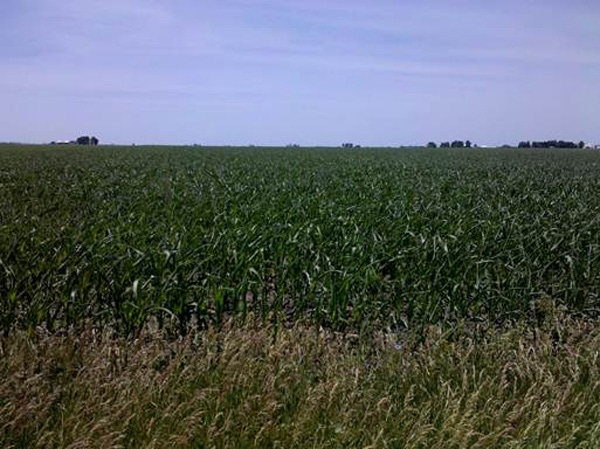June 24, 2016

Whether in the presence or absence of adequate soil moisture in the soil profile, heat stress can be an important risk and/or limitation to plant growth and development. While some crops are more susceptible to heat stress during critical growth stages [e.g., pollination for corn and R3 (flowering) stage for soybean], both corn and soybean are also susceptible to extreme heat (and water) stress during early vegetative stages.
While options are limited for mitigating the negative impact(s) of extreme heat stress on crops, there are several practical options, especially in irrigated settings.
Monitoring soil moisture during heat wave periods is critical. Maintaining adequate moisture in the soil profile is crucial to reducing the impact of heat stress on crops. Tools and procedures for effective irrigation management are available on the Nebraska Agricultural Water Management Network (NAWMN; Irmak, 2005; Irmak et al., 2010) website.
While we use advanced instruments in our research programs to decisively distinguish heat stress from water stress (and nitrogen stress), a quick, practical way to check for heat stress is to evaluate the leaf and canopy structure during the early morning hours when air temperature is low. If the leaves are curled and soil moisture in the soil profile is adequate, the symptom is most likely due to heat stress. Curled leaves can also reduce the light/radiation interception and this, in turn, can negatively impact plant water and nutrient uptake and transpiration rates. Another practical way of checking for turgidity of the plant leaves and stems is to break the leaf and/or stem and check for the status of the plant water (sap) in early morning hours and repeat this again during solar noon hours (around 3 p.m.) when air temperature is usually at its maximum.
My research shows that for center pivot-irrigated crops, even if the soil profile has adequate soil moisture, making a run with the pivot and applying 0.25-0.40 inch of water can be very beneficial to reduce the sensible heat (heat that is used to heat the soil-plant environment) during a heat wave. The heat that exists in the environment will be used to warm up (and evaporate) this additional water and this would, in turn, reduce the soil-plant canopy temperature due to evaporative cooling. The interval for this pivot run with a small amount of water can be every three to five days, depending on the irrigation well, center pivot capacity, and duration of heat wave.
The process of making a quick run with the center pivot and applying 0.25-0.40 inch of water is not only beneficial during early growth stages, but it can also be effective and beneficial to cool down the plant canopy and help enhance plant metabolic functions/activities during heat waves in reproductive stages as well.
Similar options for gravity-irrigated and subsurface drip-irrigated crops are limited. However, my research shows that subsurface drip-irrigated fields are naturally cooler than center pivot-irrigated fields due to increased transpiration rates in the subsurface drip-irrigated field that result in greater evaporative cooling. More energy (heat) is used in the subsurface drip-irrigated field than in the center pivot field and this reduces the amount of heat in the environment.
Adding this additional small amount of water can be especially beneficial if the crops are in very early vegetative stages where their roots are not as developed. Applying a small amount of water should not prevent plants from developing roots into deeper soil layers because plant roots penetrate deeper into the soil profile for many reasons in addition to searching for soil moisture. Other reasons include:
Developing a stronger plant structure
Searching and uptaking soil nutrients and micronutrients
Maintaining adequate root-shoot ratio
Thus, even if the soil moisture in the upper soil layer is kept adequate, plants will continue to develop roots into the deeper layers. Having said that, plants grown in fine-textured soils will usually have deeper roots than those grown in coarse-textured soils for reasons other than soil moisture.
It's more critical in coarse-textured soils (e.g., sandy, sandy-loam, and similar soils) than in more fine-textured soils (e.g., silt-loam, silty-clay loam, and similar soils) to keep the upper soil layer in adequate soil moisture in early growth and development stages.
My research showed that in reduced or no-till corn and soybean fields, soil temperatures in the surface soil layers can be up to 8-10° F lower than in disk-tilled fields. Reducing soil temperature during heat waves can greatly help to mitigate the impact of heat stress on plants. Additional residue on the soil surface in reduced and no-till fields can minimize the radiation (heat) interception on the soil surface and alter the heat exchange between the soil and surrounding microclimate. This reduces soil temperature. Reducing soil temperature is beneficial for enhancing root growth and water and nutrient uptake during heat wave periods.
Soil fertility can also impact the degree to which heat and water stress affect plants. Plant stomatal conductance and the transpiration rate under water stress conditions were observed to be lower under good compared to low fertility conditions. Also, under heat stress soil fertility improved by applying macronutrients such as potassium and calcium and micronutrients such as boron, manganese, and selenium. These applications modified stomatal function and activated physiological and metabolic processes that helped in upholding high tissue water potential and increasing heat stress tolerance.
You May Also Like




